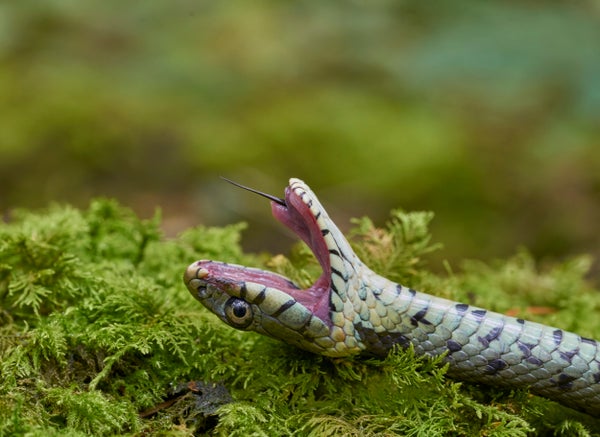This article was published in Scientific American’s former blog network and reflects the views of the author, not necessarily those of Scientific American
The domestic chick (Gallus gallus domesticus) entered the arena and zeroed in on the delicious-looking Indian stick insect (Carausius morosus) that was already there—a feast ready for the diner. The bird approached the insect at once, but almost immediately the prey went stiff. It extended its thin limbs along its long body and froze—looking more than ever like a piece of dead wood—as the chick attacked it. Then the chick stopped moving too. For a fraction of a second, the bird seemed confused, and then started to furiously shake its head and wipe its beak as if repulsed. Finally, the chick moved away, leaving the very much alive—and mostly unharmed—insect behind.
The life-and-death struggle took place at Newcastle University’s Institute of Neuroscience, in the laboratory of John Skelhorn, a researcher who specializes in the study of predator and prey delusions. Skelhorn’s recent research, published last October in Current Biology, set out to better understand the phenomenon known as ‘thanatosis,’ in which prey play dead to thwart the attack of predators.
Prior to Skelhorn’s study, other researchers had speculated that thanatosis might exploit the tendency of predators to avoid dead prey, but the hypothesis had never been tested, and remained controversial. To find out, Skelhorn divided domestic chicks into three groups, each containing 30 birds. Each of the 90 chicks entered an experimental arena a total of 4 times (with each visit lasting 2 minutes) prior to the actual test.
On supporting science journalism
If you're enjoying this article, consider supporting our award-winning journalism by subscribing. By purchasing a subscription you are helping to ensure the future of impactful stories about the discoveries and ideas shaping our world today.
The items that the birds encountered during their pre-trial visits differed among the three groups. The first group found a regular, unmanipulated dead stick insect laying on the arena. The second group found a manipulated dead stick insect, which had been bound in purple cotton thread to change its appearance without altering its physical structure or odor. And the third group found an empty arena.
Then, each bird experienced a single test trial with a lone, live insect.
Because stick insects vary in their tendency to perform thanatosis under attack, only about half of the insects played dead in each of the three groups —thereby producing six experimental groups (the three original bird groups, with the insects either playing dead or not for half of the birds in each group).
Critically, in the pre-test trials, birds who had encountered dead insects found them unpalatable. Chicks unvaryingly displayed standard disgust responses, and did not consume a single dead bug, whether manipulated or not.
During the test trial, all birds attacked the insects, and their attack speed was equivalent in all six bird groups. This proved that having a prior aversion to dead prey did not make the birds more reluctant to attack live prey. However, there was a large difference how many chicks rejected their prey post-attack in the different groups. Chicks that had been exposed to regular dead insects rejected prey displaying thanatosis in greater numbers than chicks who had found manipulated dead insects, or chicks who had not been exposed to dead insects at all.
Skelhorn’s findings indicate that thanatosis is effective only in conjunction with a predator’s prior experience with dead prey, while being unsuccessful with naive predators. This discovery adds to the growing body of research—including Skelhorn’s previous work—suggesting that cognitive processes play important and largely unexplored roles in the evolution of prey and predator behavior.
